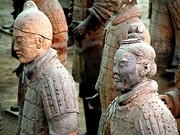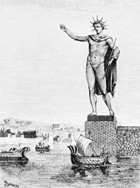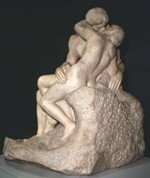WORLD'S GREATEST 3-D ART | SculptureSculpture is the only branch of the fine arts concerned with three-dimensional forms of expression. Traditional sculptures have been carved or chiseled from a wide variety of natural solid materials, including animal bones, clay, stone - such as hard limestone (marble) - wood, and precious metal. With the development of new sculptural tools and technology, artists progressed from bone, wood, clay and stone, to casting in bronze. The principal models for this form of art derive from Greek sculpture and Roman Sculpture of Antiquity. Following the progress of Baroque sculptors and those of the Neo-Classicaland 19th Century periods, twentieth century sculpture has widened the genre by producing non-functional and non-representational 3-D works, by using a limitless range of materials (eg. bicycle-parts, steel, plastics, stained glass, sand and ice) and by creating new forms of spacial and kinetic sculpture (3-D forms designed to move). World famous sculptors include Donatello,Michelangelo Buonarroti, Tilman Riemenschneider, Giambologna, Giovanni Bernini, Jean-Antoine Houdon, Antonio Canova, Auguste Rodin, Pablo Picasso, Constantin Brancusi, the 19th century Alfred Stevens and GF Watts, English virtuoso Henry Moore and the contemporary sculptor and installation artistDamien Hirst. |
 Chinese Terracotta Warriors, part of the hoard of 8,000 Terracotta Army clay statues and horses which were discovered in 1974 next to the mausoleum of the First Qin Emperor Qin Shi Huangdi, who died in 210 BCE in Shaanxi province, China. It is the greatest example of representational art. | Types of Sculpture The basic traditional forms of this 3-D art are: free-standing sculpture, which is surrounded on all sides by space; and relief sculpture (encompassing bas-relief, alto-relievo, and sunken-relief), where the design remains attached to a background, typically stone or wood. Examples of relief work can be seen on Trajan's Column in Rome, the Temple of Zeus at Olympia, and the Parthenon.Gothic architectural reliefs appear on all major European Cathedrals of the period: witness the Saints on the south trancept of Chartres cathedral, and the apostles on the north trancept of Rheims cathedral. It can also be classified by its subject matter. A statue, for instance, like the two versions of David by Donatello (1386-1466) and Michelangelo (1475-1564), is usually a representational full length 3-D portrait of a person, while a bust usually depicts only the head, neck and shoulders - see the bust of George Washington (1788) by Jean-Antoine Houdon (1741-1828). A statue of a person on horseback, such as the one by Giambologna (1529-1608) of Cosimo de' Medici in Florence, is termed an equestrian sculpture. |
For information about the use of | Sculptural Methods and Materials Sculpture, sometimes described as one of the 'plastic arts' due to its the use of materials that can be plasticized or molded, has traditionally been created using four basic methods: wood carving, stone carving, bronze casting and clay firing. Wood Sculpture Sculpting in wood, a convenient process for small works, was practised widely during the Stone Age and Bronze Age by most cultures. An extraordinary example is the Neolithic oak-carved figure known as the 'Thinker From Cernavoda', discovered in Romania. Woodwork had its Golden Age in the West during the Medieval Romanesque or Gothic period, and during the Northern Renaissance: witness the exquisite religious limewood carvings of the German artist Tilman Riemenschneider (1460-1531). Later, in the Baroque era, the wood was often coated in plaster stucco and painted, in the manner of ancient Egyptian art. Modern wood-sculptors include Henry Moore (1898-1986) known for his elmwood Reclining Figure (1936), and Barbara Hepworth (1903-75). |
 The famous Colossus of Rhodes (Chares of Lindos) (c.280 BCE), one of the Seven Wonders of the Ancient World, which was toppled in an earthquake in 225 BCE. Over 100 feet high, it was the tallest stone sculpture of the Greco-Roman world. | Stone Sculpture Sculpting in stone, probably the earliest form of sculpture as well as the best medium for monumental works, was common to all eras of the Stone Age. An early example is the Venus of Willendorf (c.30,000 BCE). All types of stone have been sculpted, including igneous (eg. granite), sedimentary (eg. limestones and sandstones) and metamorphic (eg. marble). Pure white Italian Carrara marble was used in Roman art and in the Early andHigh Renaissance by artists like Donatello and Michelangelo, while Greek artists preferred Pentelic marble to make the Parthenon sculptures. Irish sculpture in the late medieval era was principally confined to Celtic High Crosses, made from granite like the Turoe Stone. Supreme examples of marble sculpture are Cupid and Psyche (1796-7) by the Neo-classicist Antonio Canova (1757-1822) and The Kiss (1889) by the French genius Auguste Rodin (1840-1917). |
Bronze Sculpture Sculpting in bronze is a complicated process which was developed independently in China, South America and Egypt. Bronze casting requires the modelling of a form in clay, plaster or wax, which is later removed after the molten bronze has been poured. The lost-wax method was a common technique during the Renaissance era. Bronze masterpieces include Donatello's and Michelangelo's Davids, Lorenzo Ghiberti's "Gates of Paradise", the Rape of the Sabines (c.1583) by Giambologna, The Burghers of Calais (1884-9) and the Gates of Hell (1880-1917) by Auguste Rodin, and Bird in Space (1923) by the Romanian abstract sculptor Constantin Brancusi (1876-1957). Clay Sculpture Sculpting in clay dates from the Stone Age. It is the most plastic of all sculpting materials, and easy to fashion. Although mainly used for preliminary models, later cast in bronze or carved in stone, it has also been used to produce full-scale sculpture. The most famous example is the Chinese Qin Dynasty Terracotta Army (the 'Terracotta Warriors'), a collection of 8,000 clay warriors and horses unearthed in 1974. Every one of the 8,000 clay soldiers is unique, with a different facial expression and hairstyle. Other materials employed to create sculptures include ivory and whalebone (see The Adoration of the Magi, c.1100, by an unknown English sculptor in the Victoria and Albert Museum), aluminium, foam rubber, sheet metal and concrete, bas well as a limitless number of everyday materials used by contemporary artists. |
Sculpture as Public Art |



No comments:
Post a Comment